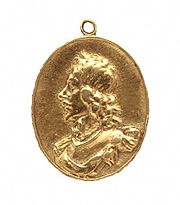Thomas Fairfax facts for kids
Quick facts for kids
The Lord Fairfax of Cameron
|
|
|---|---|
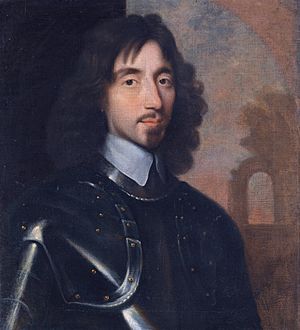
Thomas Fairfax by Robert Walker
|
|
| Nickname(s) | Black Tom Rider of the White Horse |
| Born | 17 January 1612 Denton Hall, Denton, West Riding of Yorkshire, England |
| Died | 12 November 1671 (aged 59) Nun Appleton, West Riding of Yorkshire, England |
| Buried |
Bilbrough, Yorkshire
|
| Allegiance | Kingdom of England Parliament of England |
| Service/ |
English Army Parliamentarian army |
| Rank | Lord General |
| Battles/wars | |
| Signature |  |
Thomas Fairfax, 3rd Lord Fairfax of Cameron (born January 17, 1612 – died November 12, 1671) was an important English leader. He was a general and the main commander for the Parliament during the English Civil War. Fairfax was a very skilled and brave commander. He led Parliament to many big wins, especially the very important Battle of Naseby.
For a time, he was almost the military ruler of England. However, his second-in-command, Oliver Cromwell, was better at politics and more extreme. Fairfax disagreed with Cromwell's plans, especially about putting King Charles I on trial. He refused to be part of it and later resigned. This left Cromwell in charge of the country.
Because Fairfax acted honorably in battle and helped bring the monarchy back after Cromwell's death, he was not punished like many other leaders of the revolution.
Contents
Early Life and Beginnings
Thomas Fairfax was born on January 17, 1612, at Denton Hall in Yorkshire, England. He was the oldest son of Ferdinando Fairfax, 2nd Lord Fairfax of Cameron. His family's title, Lord Fairfax of Cameron, came from Scotland. This meant he could be a member of the English Parliament.
People called him "Black Tom" because of his dark hair, dark eyes, and tanned skin.
Fairfax went to Cambridge University and later studied law. In 1639, he joined King Charles I's army. He led a group of soldiers called dragoons against the Scots. This was during the First Bishops' War, which ended peacefully. The next year, in the Second Bishops' War, the English army lost a battle. Fairfax escaped with the rest of the army. Even so, he was made a knight in 1641 for his service.
Before the Civil War

Thomas Fairfax and his father did not agree with King Charles I's way of ruling. They believed that the Parliament should have more power. Fairfax said that Parliament was the "great and safest council" for the king and the country.
King Charles I tried to gather his own army in York. Fairfax was chosen to give the King a message from Parliament. The message asked the King to listen to Parliament and stop raising troops. This happened at a large meeting in Yorkshire. The King tried to ignore Fairfax and ride away. But Fairfax followed him and placed the message on the King's saddle.
The English Civil War
When the English Civil War began in 1642, Fairfax's father became the general of Parliament's forces in the north. Thomas was made a lieutenant-general, leading the cavalry. Both father and son fought bravely in Yorkshire.
In 1643, Fairfax's small group of Parliamentarian soldiers fought the King's Royalist forces at Seacroft. Fairfax had to retreat. He called the Battle of Seacroft Moor "the greatest loss we ever received."
Despite some defeats, the Fairfaxes were often successful. They were always energetic and clever. They kept fighting until 1644. That year, the city of York was under attack by Parliament's forces and the Scots. Prince Rupert came to help the King's side.
This led to the important Battle of Marston Moor on July 2, 1644. This battle decided the war in the north. Young Fairfax fought very bravely. He was badly hurt but managed to join Oliver Cromwell and the winning cavalry. One of his brothers was killed in the battle. After this, the King's supporters lost hope in the north. York was captured, and Parliament controlled most of northern England.
In other parts of England, the King's side was still strong. The war had lasted two years, and people were tired of the fighting. Parliament decided to make changes to its army. They passed the Self-denying Ordinance. This meant that members of Parliament, like the Earl of Essex, could not be army commanders.
Then, the New Model Army was created. This was a new, unified army, not just local groups. Sir Thomas Fairfax was chosen as the new Lord General, the main commander. Cromwell became his second-in-command, leading the cavalry. The New Model Army quickly proved how good it was. Fairfax showed his skill as commander-in-chief at the very important Battle of Naseby on June 14, 1645.
The King fled to Wales. Fairfax then captured several towns like Leicester, Taunton, Bridgwater, and Bristol. Soon, Parliament controlled all of western England.
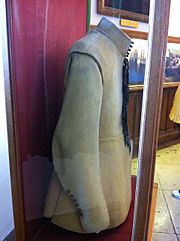
Fairfax arrived in London on November 12, 1645. Crowds cheered him as he traveled. Parliament thanked him and gave him a valuable jewel and money. The King had returned from Wales and was at Oxford. But he secretly left and went to the Scottish army at Newark. Oxford surrendered in June 1646 after a long attack. By September 1646, King Charles had no army or forts left in England.
In January 1647, the Scots handed the King over to Parliament. Fairfax met the King and traveled with him. He treated the King with great respect. King Charles said, "The general is a man of honor, and keeps his word."
After the King's side lost, there was a confusing time. Parliament, the King, the Scots, and different religious groups argued. The New Model Army became very involved in these talks. Fairfax was caught between his officers and Parliament. In July, a soldier named Cornet Joyce took the King. This showed that Fairfax could not fully control the army.
Fairfax was better at leading soldiers than at political meetings. He felt things were getting out of his control. His officers were listening more to the cleverer Cromwell. Fairfax tried to resign as commander-in-chief, but he was convinced to stay. He remained the official head of the army.
Before the Second English Civil War began, Fairfax became Lord Fairfax after his father died. He also became governor of Hull. In 1648, he showed his old energy and skill fighting the Royalists. His actions ended with the successful siege of Colchester. After the city surrendered, he agreed to the execution of Royalist leaders Sir Charles Lucas and Sir George Lisle. He believed they had broken their promise. At the same time, Cromwell won a great victory at the Battle of Preston. This crushed the Scottish Covenanters who had joined the King.
John Milton, a famous writer, asked Fairfax to bring peace to the country. Fairfax agreed with Cromwell and the army that King Charles should be punished. He was still the army's leader. He approved of Pride's Purge, where soldiers removed members of Parliament who disagreed with the army. However, on the most serious issue, he openly disagreed with the officers. He was chosen to be a judge at the King's trial. He attended the first meeting but then left. It seems he did not want to be part of executing the King.
During the trial, when Fairfax's name was called, his wife, Anne Fairfax, reportedly shouted from the audience. She said he was too smart to be there. Later, when the court claimed to act for "all the good people of England," she shouted, "No, nor the hundredth part of them!" She was then asked to leave the court.
Fairfax's last duty as Commander-in-chief was stopping a soldier uprising at Burford in May 1649. He had accepted the new government and was reappointed Lord General. But he mostly managed army matters. In 1650, when the Scots supported Charles II, Parliament decided to send an army to Scotland. Fairfax could not support this war and resigned his position. Cromwell became the new commander.
After the War
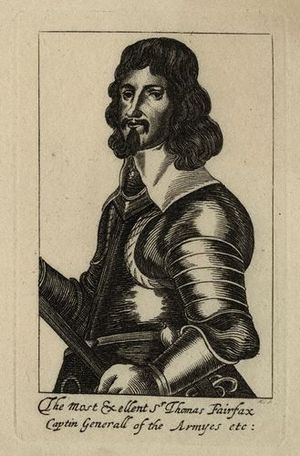
During the time England was a republic (the Commonwealth of England), Fairfax was elected to Parliament in 1654. He received a yearly payment of £5,000. He lived quietly at his home in Yorkshire, Nunappleton, until Oliver Cromwell died in 1658. The poet Andrew Marvell wrote a poem about Fairfax's home and his quiet life there.
When problems arose in England after Cromwell's death, Fairfax returned to politics. In 1659, he was elected to Parliament again.
Bringing Back the King
Fairfax's actions helped shape England's future one last time. George Monck, another general, asked him for help against John Lambert's army. In December 1659, Fairfax appeared with a group of Yorkshire gentlemen. Because of his fame, 1,200 of Lambert's soldiers left and joined Fairfax. Soon, all of Lambert's forces broke apart. This helped bring the monarchy back to England.
Because of these actions and his honorable behavior during the Civil War, Fairfax was not punished by the King's supporters. In April 1660, Fairfax was re-elected to Parliament. He led the group from Parliament that went to the Hague to ask Charles II to return quickly. His actions helped bring back the Stuart kings. Fairfax even provided the horse that Charles rode at his coronation.
Later Life and Family
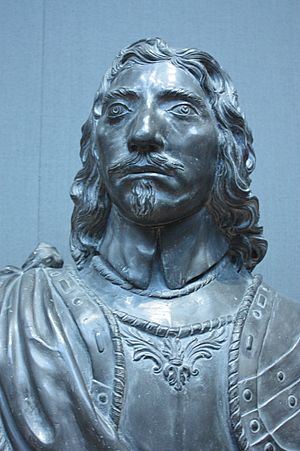
Lord Fairfax spent his last eleven years living quietly at his home in Yorkshire. His wife died in 1665. Thomas Fairfax died at Nun Appleton Priory in 1671. He was buried at Bilbrough, near York.
Fairfax married Anne de Vere on June 20, 1637. They had one daughter, Mary Fairfax (born 1638 – died 1704). She married George Villiers, 2nd Duke of Buckingham.
Fairfax's cousin, Henry Fairfax, 4th Lord Fairfax of Cameron, became the next Lord Fairfax.
In Books and Movies
Thomas Fairfax has appeared in many stories and films:
- In the 2003 film To Kill a King, he is played by actor Dougray Scott.
- He is a main character in Rosemary Sutcliff's historical books Simon (1953) and The Rider of the White Horse (1959).
- He is also in Howard Brenton's 2012 play 55 Days.
- Douglas Wilmer played him in the 1970 film Cromwell.
- Jerome Willis played him in the 1975 film Winstanley.
- He appears in Michael Arnold's book Marston Moor.
- He was a main character in the 1988 BBC Radio play God's Revolution.
See also
 In Spanish: Thomas Fairfax, III lord Fairfax de Cameron para niños
In Spanish: Thomas Fairfax, III lord Fairfax de Cameron para niños


